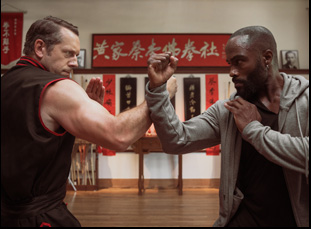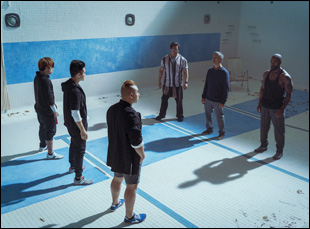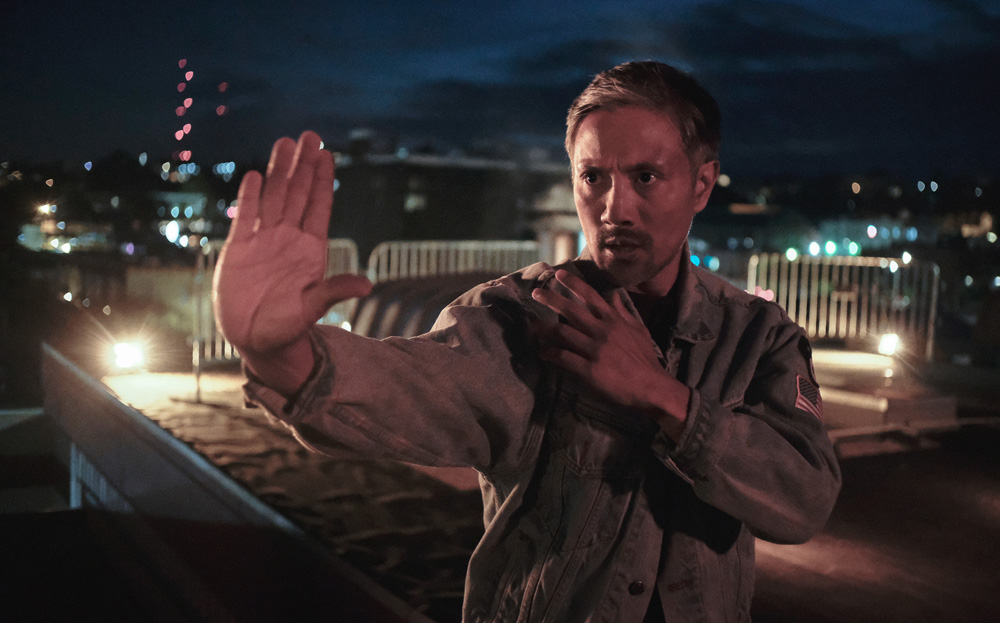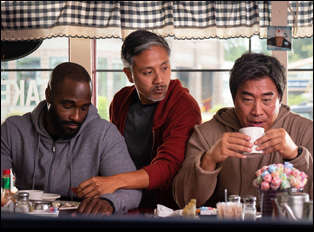Usually, epic martial arts films unfold in exotic locales, but Bao Tran recognized one closer to home. Growing up in Seattle, his parents had encouraged an interest in martial arts when it would mean he would get away from the television, though rather than watch shows, he had always been more interested in making them, leading Tran to pick up a camera and film short movies with friends, making up for what was missing in terms of a proper budget with passion to spare. Life would take the friends in different directions while Tran continued to pursue filmmaking, led back to his family’s roots in Vietnam where he became an accomplished editor, but still nursing the dream of directing his own film with the same enthusiasm he had when he was younger.
Tran didn’t need to look any further than within himself for inspiration for what would become his feature debut “The Paper Tigers,” though to anyone else, it’s bound to look wildly imaginative, telling the story of three former Taekwondo students who are brought back together on the occasion of the death of their teacher (Roger Yuan), which appears to possibly be a result of foul play. Only one (Mikel Shannon Jenkins), now a mixed martial arts teacher himself, is in any shape to avenge their master, with the other two (Alain Yu and Ron Yuan) unfit both physically and mentally as the woes of being middle-aged with families and bills to pay have reared their ugly heads. Still, the reunion in the service of something greater than themselves proves galvanizing and while their technique may be rusty, “The Paper Tigers” has plenty of kick when returning to the fight rekindles their passion in other areas of their life.
Although Tran is fully invested now in filmmaking, his own days of martial arts lessons show, not only in the impressive staging of set-pieces, but how he deflected opportunities to make “The Paper Tigers” over the years that would’ve in some way strayed from his original vision, instead turning to the Asian-American community to help him make a film on his own terms. The result speaks for itself when the film wears its considerable heart on its sleeve without pulling any of its punches and shortly before it arrives in theaters and on demand, Tran spoke about how the film grew out of its setting in the Pacific Northwest, as well as the inclement weather that could mean for the production, and how much harder it is to create a good fight scene involving actors working towards making it look bad intentionally.
This story has been basically 10 years in the making to get to where we are today. I started writing, or started noodling on the idea about 10 years ago, primarily because I made films at an early age, just doing it as a passion and hobby, but then it’s another thing to go into it as a profession. I was feeling a little burned out by the business side of moviemaking, so I had to be a little self-introspective and just think about all the things that were happening in my life and what I was passionate about, which was film and martial arts. That got me to thinking about this whole journey of going back to your roots, or rediscovering something that you were once passionate about, but to put it in a fun entertaining vehicle. Does it still have any meaning for you? What does it mean for you moving forward?
Also, we shot this in Seattle, and it’s a bit of a love letter to the martial arts history here with Bruce Lee, who first settled down and opened his Kung Fu school when he came to America. He met his wife here and went to the University of Washington, and he was one of the first to teach non-Chinese [students] and a lot of them are still around, passing on what they learned from Bruce firsthand, so all that comes together in this little package of this love letter to Seattle martial arts, but also to rekindling the passions that we once had.
One of the things loved was how you were often able to bring locations into the film – they were integral to the fight scenes you had and the settings in general really come alive. Did you build the script around them?
Well, it’s a little hardscrabble. Independent film is never clean, and never does everything happen to schedule. There’s always something new every day, and another fire to put out, but because we knew the city, it helped us when locations fell through, or some snafu came up. We could find another location as an alternative, or we could call a friend or a contact that we knew that had a place, or even just housing the actors and crew that was coming up, finding little places for them to stay in. It was just a whole grassroots effort for the community that helped support the film, so we’re very thankful for that.

Yeah, for me, rehearsal is a lot of stuff because we also have action rehearsals, so sometimes there’s workouts and training and choreography practice and somethings we get to wax poetic about the script. In terms of the schedule that we had, we had to split the time between me and our action director Ken Quitugua and the action team, but my objective was try to get them as familiar with each other as possible, [asking] how do we get to that best friend mode as soon as we can? Because these actors are the first time they’ve ever seen each other, so they are coming in as complete strangers and to serve the story, they need to be the best of friends, so it was a bit of a challenge to get through that. I like to work with improv to start developing back histories and relationships, so I don’t really do a lot of scene work in the rehearsals, but on the day, you’ll start to do that together, building that on its feet. Otherwise, you get the actors in their heads, [where] he’s doing this one thing, and [someone else is] doing this other thing, [but instead] they’ll put it all together and put it in that soup, so hopefully that paid off.
It did. When you’ve got fights that need to be staged perfectly so no one gets hurt, is it difficult to design them where the fact that the characters are supposed to be rusty and out of shape is taken into account?
Yeah, we pitched it as is the Shaw Brothers in a street fight, so you had the flavor of Shaw Brothers, but also it’s sloppy, out of tempo, and you’re late to a hit or your footing is not as sure, so it was a bit of a deconstruction in that sense of what is a good fight scene? And how do you dirty it up a bit? That was a learning process for us, because by experience, we like to create good action that’s strong and powerful. I’ve made many other pieces that are a little bit more forward type of action, but [we had to ask ourselves] how do you peel back from that? We had to break our own habits too, because sometimes you didn’t want the take that was super clean. You wanted the second-best take where the kick was a little bit off, or the actor slips, and use that, so that’s the process of discovery.

It was, and it was two fold. One, the editing and the ability to visualize how a scene is going to come out is a really good skill that I learned through that process, so that when you shoot it, you know how it’s going to cut. That was invaluable. The second was an appreciation for other modes of filmmaking. I started out basically guerrilla style, like a DIY Robert Rodriguez. [His book] “Rebel Without a Crew” was just super influential when I started out, and I never went to film school, so I didn’t do that traditional division of labor [where there are different departments] like director, editorial, camera — I just see it all. When I write, I think of how to edit. When I direct, it’s always figuring out how it all comes together as a whole. But when you go to Asia, they have a different structure [where] it’s not always top down or hierarchial. In Asia, you have a whole team that directs the action soup to nuts. They’ll design, and previs and then shoot it. On the day, they actually run the set, and then they edit. That, to me, makes the most sense, because you don’t want to just hand off action to a team who may not know how to cut action, but you want to be able to have a creative hand in the whole creation of action scenes, so bringing that back to the States was a bit of a challenge, because there’s a lot of bureaucracy and red tape in terms of just not allowing that to happen, which is counterproductive. But if we’re not allowed to be the most creative, and be our best selves on the day, then let’s get rid of the bureaucracy, so we had to do some fancy dancing to make it work on the day with the American crew, but eventually you got the hang of it.
Was there a particularly crazy day of filming?
Every day was crazy. With any new film, it’s just one darn thing after another, but as a whole, I just appreciated the grit that our whole crew showed, and the ingenuity of working through problems. There was one memorable one that was almost at a point where it’s so out of our control, it really was like an act of God. We were on the rooftop shooting the finale, and we had the biggest thunderstorm come through in the last 15-20 years — there was a University of Washington football game going on, and they had to cancel, it was that bad. So we were on a rooftop with metal rods all around us, and for safety, we obviously had to clear set, but we lost about five hours from shooting those night scenes, and in production, when the sun comes up, you’re done, so the time window was already limited as it was, and to lose more time was really challenging. But it was a testament to the crew, just bouncing back and figuring out a way to get it done. And that was memorable because you can decide and plan all you can, but it comes to a point where it’s so out of your hands and we were literally, downstairs, just playing board games, just waiting it out.

What I love about filmmaking is that it surprises, and you take that with the good and the bad. When you have good surprises — when you have actors that come in with their own ideas that can add another depth, or another level to it — that’s great. When you have a production designer, a [director of photography], or action director who has ideas that you could never think of, that’s the beauty of film to me. I’m very happy with how it turned out. I would never have imagined it to be this way, but in terms of just having the right people, I’m just thankful for them to be able to give their contribution to the film, and it just made it all better. Many hands make easy work, in that sense.
I was really intrigued to hear you knew Corey Yuen, the legendary director and martial arts choreographer, growing up in Seattle. How did you meet him?
He’s a family friend — and again, I didn’t go to film school, I’m not from a showbiz family, I don’t have any of that experience — so it was just pure wonderful happenstance that I I was making movies as a kid in the backyard and to have him open up about his experience, and be in my life was was just huge. That was my Masterclass, and for him to just spend the time and watch my silly backyard videos and shorts, and eventually it got bigger and bigger — to be able to share that whole development with him is a real special memory that I have. He was able to stress the importance of story with action — don’t just do action, think about story first. These are lessons that I still carry to this day in thinking about anything moving forward. Start with a story, [and ask] how does the action serve that story? So he’s my movie Sifu, and in many ways, this movie is a love letter to our teachers, and our mentors and anyone who set the path before us. In a lot of ways, this is a token of appreciation for what he gave me.
“The Paper Tigers” opens in select theaters, iTunes and on VOD on May 7th.





